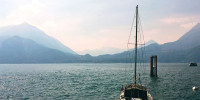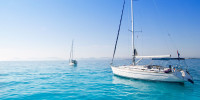How To Anchor a Boat Overnight: Sleep Steady with These Tips
We love anchoring out overnight. Why? So many reasons. Boats interiors have the best airflow pointing into the wind, so it's comfortable. The gentle motion and noises, and the quiet away from land and people and restaurants and crowds. We sleep really well at anchor.
But many people don't, because they aren't comfortable anchoring, and they don't take the right steps to make sure you can get a good sleep. If you pick a suitable spot for the expected weather, set the anchor properly, make sure you've got some good anchor watch tools, and you've gotten comfortable doing it, you'll get a good night's sleep too.
It's not magic, and you can learn to set yourself up to enjoy that morning coffee in the cockpit feeling well rested.
How to anchor a boat overnight
- Pick a good spot (for the weather) with enough swing radius
- Set the anchor well
- Maintain an anchor watch
- Get comfortable with anchoring

Picking a Good Place to Anchor
If you're in an untenable anchorage, you won't sleep well. You'll wonder all night if something is wrong and end up sticking your head out of a hatch at every wind shift. Picking a suitable spot is a matter of planning, preparation, and observation.
A good anchoring spot has:
- Excellent protection from the range of wind and weather you expect
- Is shallow enough to allow for proper anchor scope
- Has a clear swinging radius through all possible wind directions.
- Isn't so crowded you can't let out enough scope
- Doesn't have any tricky hazards which you can swing into or over.
You've got some excellent tools to find these places, including charts, cruising guides, the internet, and your eyes. We describe some of these in How to Anchor a Boat.
Anchoring and Weather:
Always check the weather when you're out in the boat, every day. A comfortable anchorage in a northerly may turn into a lumpy, awful washing machine that drags your anchor if the wind swings 180° in the night. Look for open stretches of water where you're anchored; if the wind shifts from that direction, it can get uncomfortable.
Setting the Anchor Properly
There's nothing like knowing you set the anchor well to help you sleep at night. When you've done it right, you'll know, because you've backed down on the hook and your boat doesn't move.
For the actual anchor drop and set, the steps are quite simple once you figure out where you want to anchor.
- Idle upwind close to the point we want to drop, then drift to it in neutral.
- Signal the drop to the person on the bow
- Allow the boat to drift back as the anchor drops.
- Pay out limited rode until you reach 3:1 scope, then stop and allow the anchor to catch the bottom. If done right, this should make sure no chain piles up on the bottom.
- Put the engine idling in reverse until the anchor stretches and the anchor sets.
- Pay out more rode until you reach the desired scope.
- Back down more firmly on the chain (not too fast) to set the anchor hard.
For more detail, check out How to Anchor a Boat.
Anchor Watch
When you drop the anchor, maintain a manual anchor watch for a set time to make sure it all held, and you set everything right. On our boat, we don’t leave until at least an hour after we've set, while checking the boat's position with a hand bearing compass and a GPS to make sure we're not moving.
Automatic Anchor Watches
But that doesn't help you over night. To get a good night’s sleep, you'll want some automatic tools to wake you up if there's a chance you're moving and don't know it.
Instruments on Board
Your ship's instruments may have an anchor drag alarm built into them. Many do. My boat has three - on my AIS transponder, my chart plotters, and on a remote NMEA 2000 data display, back in the master cabin, right next to the bed. This is my primary anchor alarm. I don't use the other two often, as I’d need to leave more power draining instruments on.
Sometimes I use a handheld GPS with an anchor drag function. Those work well, though they use lots of batteries (and may die in the night) if you don't get a 12V adapter to power them. The other downside to handhelds is they can't always find enough satellites from below decks, so the signal may be poor or unusable.
Phone and Tablet Apps
There are many anchor drag apps available for phones and tablets to give you a hand monitoring the boat position overnight. Try out several and find one that works for you. Look for one which lets you offset the estimated anchor position from the phone.
What to Watch Out For
There are a couple of flaws with the automatic anchor watch devices. Most of these watch work with a "drag radius" concept - a circle of adjustable diameter, where if the boat moves outside this radius, an alarm goes off.
In theory, we should center this radius on the anchor. But it's almost always centered on the GPS antenna, unless you take steps to offset it. If you drop the anchor and let out 200' of chain, then turn on your app on your phone in the aft cabin on a 40' boat, the center of that radius is almost 200' away from the actual anchor.
That creates false alarms if the wind shifts, because you can swing well outside the device’s "drag radius" while still being well within the actual radius of your normal anchor swing. If you set the drag radius for 250' and the wind swings you 180° and pushes you out to the end of the chain in the other direction, your drag alarm will go off. Even though you aren’t dragging, you have moved over 250’ from the starting position.and outside the app’s drag radius.
Now, this isn't the worst thing, because a big change in wind direction and speed may cause your anchor to break out. But it's annoying when you get a lot of false alarms.
There are a few ways to fix this.
- Use a tool which allows you to offset the estimated anchor position and direction, to give a better radius.
- Use a handheld, but have someone stand on the bow and set the radius right when you drop the anchor.
- Estimate where the anchor actually is, and enter those coordinates instead of the current GPS position.
- Figure out how best radius settings to minimize false alarms for your device without complicated math. This takes practice and experimentation.
Manual Watching
You may wake up at night. This is normal. It's not the waking up that makes you sleepy the next day, it's not falling back to sleep. But if you wake up, there's usually a reason or it. Something may have changed or made a noise which disturbed you.
While you can't stay up all night watching for anchor dragging, you can pay attention to your boat and make a few observations to help you know if everything is OK.
First, listen. If you have a wind generator, changes in pitch are a great tip that something has changed with the wind. But other noises, like splashing on the hull and rigging noises, may tip you off that conditions outside aren't the same as when you went to bed.
Keep some instruments on, so you can quickly look at a compass heading, GPS speed over ground, and wind direction and strength without getting up and waiting for it to all start up. Just knowing that you're still pointed the same way, the wind hasn't changed, and you aren't moving is often enough to help you back to sleep.
And before you go to bed, look around where you're anchored. Note the relative position and compass heading of any lighted buoys or landmarks. You can check these any time you're concerned you may have moved, just to back up your instruments and devices.
Getting Comfortable
The best tool for sleeping at anchor is practice. It's getting comfortable with your anchoring skills, learning the noises your boat makes at night, and how your instruments and alarms work.
The more you anchor out, the more you learn, the better you get at it, and the better you will sleep. Experience and practice will do more for you than any articles you read or apps you put on your phone.
Other Questions
How do you know where to anchor?
You're looking for a spot protected from wind, boat traffic, waves, and other hazards. See how in our How to Anchor article.
How long can you stay at anchor?
If there are no local ordinances and anchoring laws restricting time at anchor and you're in a legal spot, you can anchor as long as you like. It's not recommended that you leave your boat unattended at anchor for days on end, but if you're on the boat, stay as long as you want.
Can you anchor and moor anywhere?
No, you cannot anchor anywhere. Harbor entrances and shipping channels, too close to marinas and beaches, and many other safety considerations limit where you can anchor. Also, local authorities may regulate anchoring, banning it or limiting the time you can spend in any one spot. The good news is, the restricted areas make up a tiny percentage of the waterways, so there are plenty of safe, legal places where you can anchor.
Did you find the answer to your specific question?
👍 3 👎 1




Leave a comment